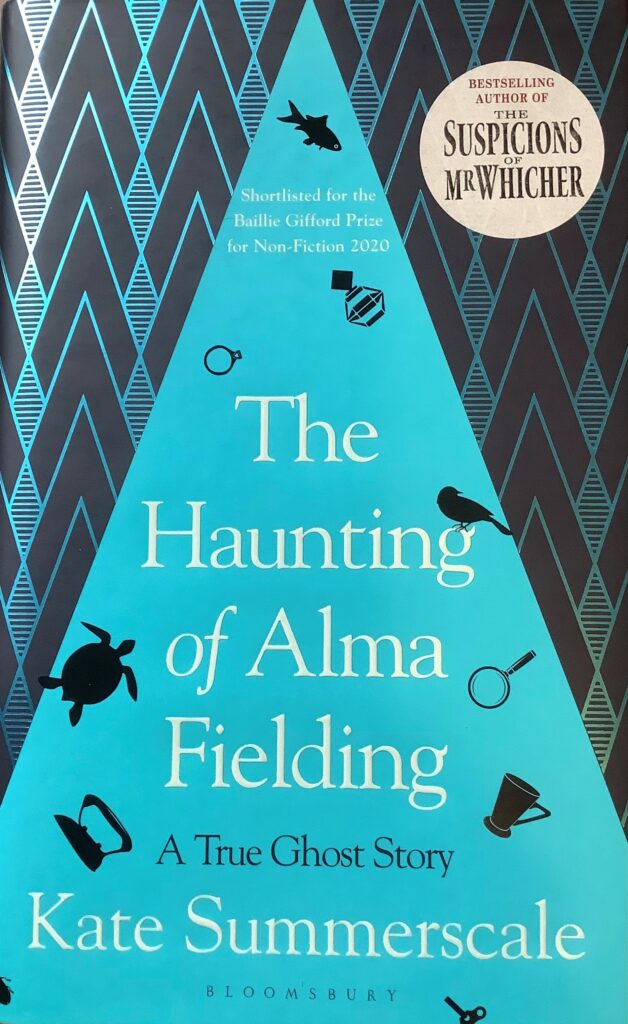
Kate Summerscale, The Haunting Of Alma Fielding: A True Ghost Story. London, Bloomsbury, 2020. 345 pp. ISBN: 978-1-4088-9545-0
The curious case of Alma Fielding, previously little more than a lost footnote in the history of psychical research, has recently been rediscovered and given fresh prominence by Kate Summerscale in The Haunting of Alma Fielding: A True Ghost Story, shortlisted for 2020’s Baillie Gifford Prize for Non-Fiction. The book consists, on one level at least, of the author’s examination of a range of typical poltergeist phenomena that seemed to centre on Fielding in the early months of 1938 when war seemed simultaneously imminent and very far away: objects thrown by unseen hands, smashed crockery, apports, JOTTs, and so on. On one level – and hence the title of the book – it was as if something haunted Fielding. On another level, however, Summerscale’s tale hints that a different sort of ‘haunting’ was going on, with the gimcrackery of poltergeistery being merely a surface manifestation of a different – and much more deep-rooted – disturbance.
This mainly biographical treatment is actually that of two persons: Fielding herself and Nandor Fodor, a Hungarian émigré and the then leading psychical researcher for the International Institute for Psychical Research. In a crucial sense, both personalities needed each other: Fielding receiving – at least at the beginning – the empathy and support she needed to accept and understand her experiences, and Fodor receiving much-needed validation of his own role and methods within the Institute. Indeed, it is no coincidence that when the mutual support fell away – as it did, within a matter of months – the whole case came crashing down.
Fielding specialised in producing ‘apports’: manifestations of objects ranging from broaches to beetles which she could seemingly bring into being from nowhere. Fodor was initially impressed with these, but over time it became clear to him and his co-researchers that Fielding was simply secreting them on her person and producing them when everybody’s back was turned. Summerscale paces the narrative well as the penny drops, but even when it does drop you sense that the game wasn’t quite up, with Fodor obviously loathe to admit that the case, psychically at least, wasn’t worth a candle. Finally, though, the truth clearly became inescapable for him; his earlier support – even affection – giving way to a harshness which I found quite disconcerting. Summerscale is careful not to judge, however, letting her ‘fat folder of evidence’ – obtained from a visit to the Society for Psychical Research in 2017 – tell its own story.
Recognising that Alma Fielding was a troubled and deeply traumatised lady, Fodor eventually repented of his later harshness, but by then the relationship between the two had irretrievably broken down. His psychoanalytic treatment of the case – including an endorsement from Freud, no less – was ground breaking and paved the way for much that was to follow within his field.
Overall, I enjoyed Summerscale’s book, despite its rather pedestrian style. Indeed, apart from the somewhat plodding prose, only the historical context jarred. The building storm clouds of war might have provided the historical backdrop to the tale but they do little to enhance the narrative; distracting instead of shedding light. I found myself wondering why the author didn’t do more to weave the two ‘stories’ together, instead of placing them side-by-side as little more than two parallel plots. As is well-known, times of crisis always call forth ‘signs and wonders’. Could examination of yet another layer of ‘haunting’ have shed even more light on this odd case? Summerscale’s failure to explore this felt like a missed opportunity to go deeper still, despite the impressive depth of research exhibited elsewhere.